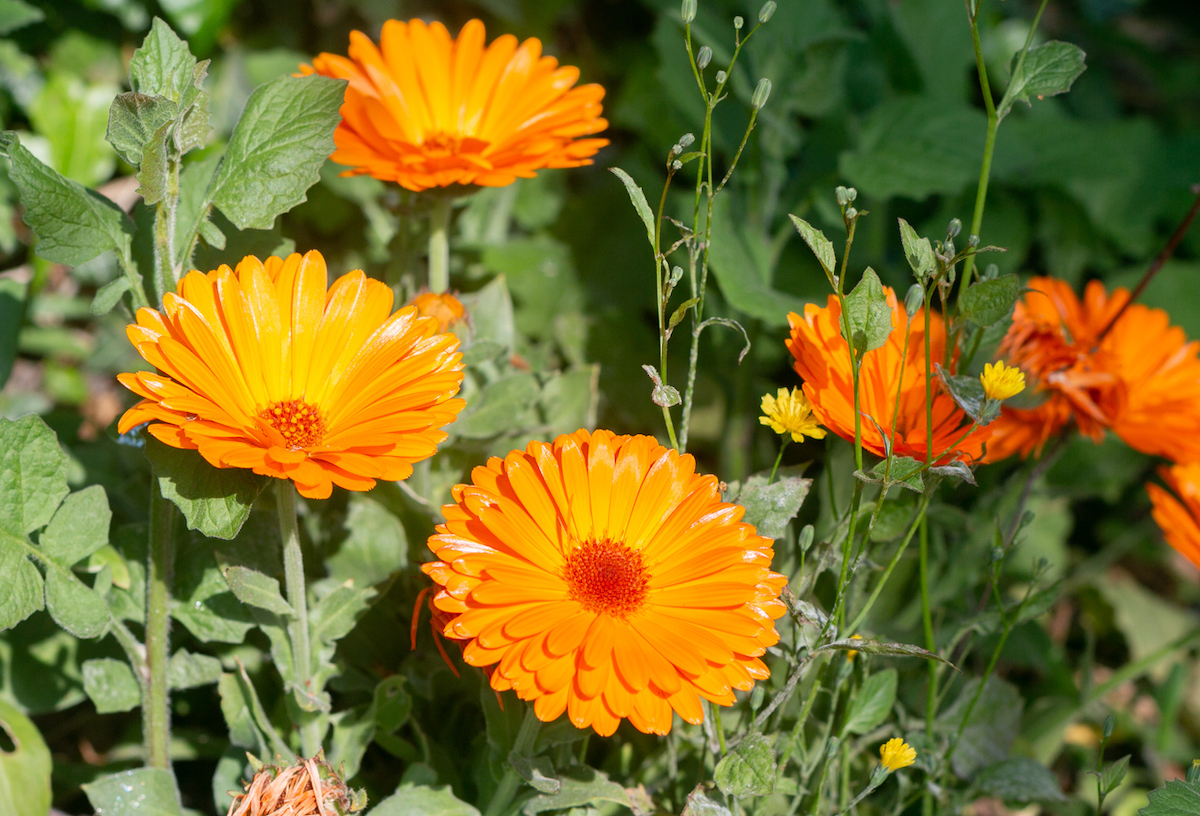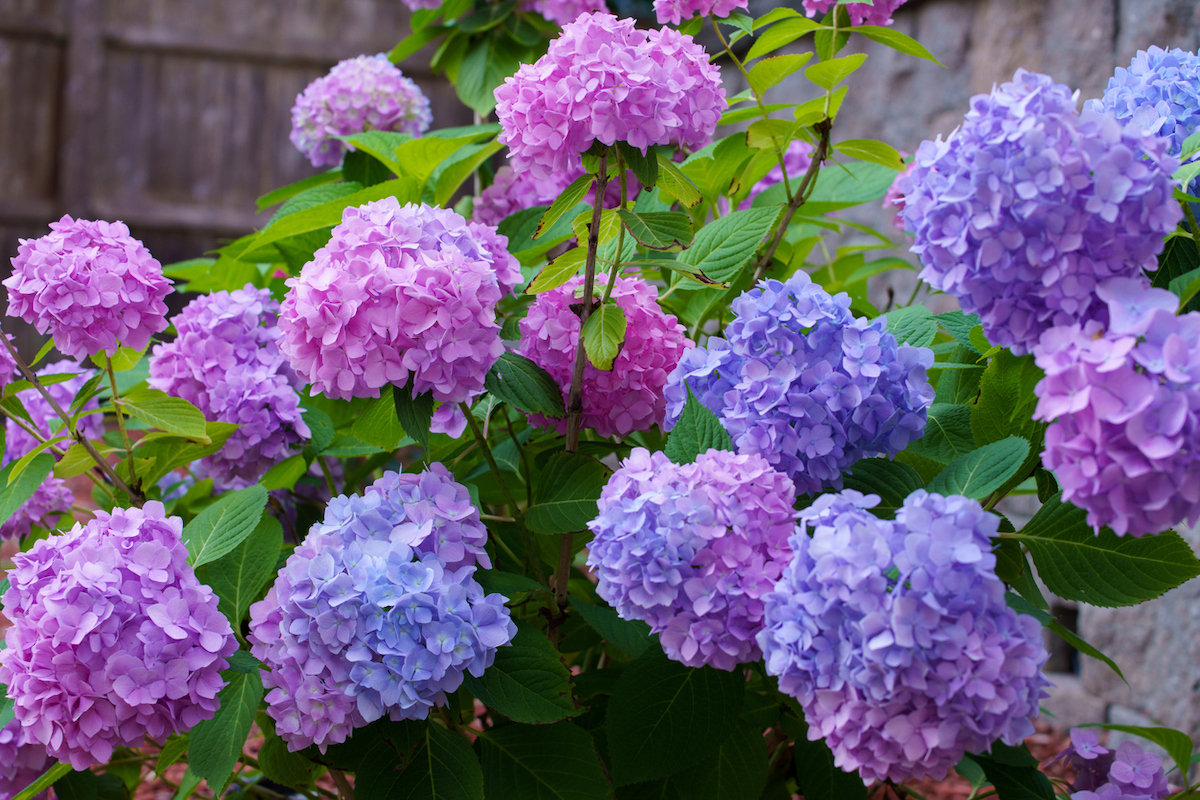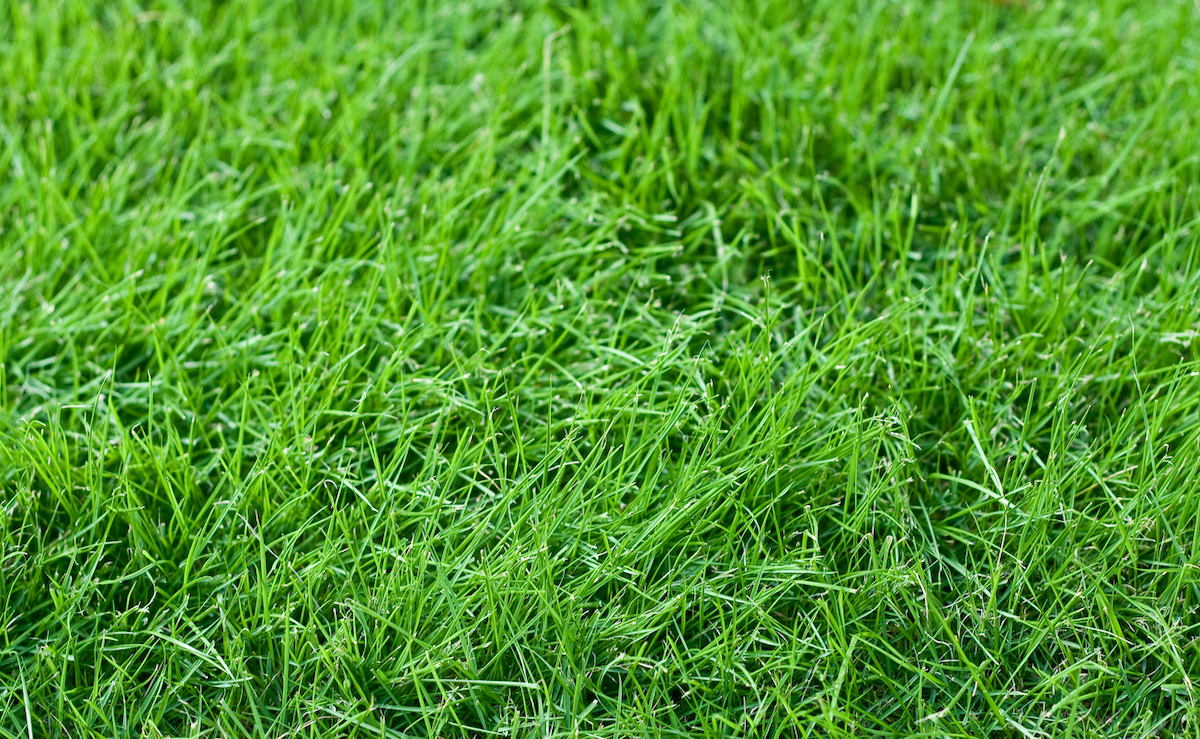

We may earn revenue from the products available on this page and participate in affiliate programs. Learn More ›
Though we may think of spring as the time to sow seeds, fall is an ideal time for planting. An array of cool-season vegetables can grow in fall’s milder temperatures and cool nights. September plantings also can include shrubs, trees, grass seed, and spring-flowering bulbs. If you’ve already checked off what to plant in your garden in August, don’t rest yet: what to plant in September includes plenty of variety, from dramatic focal points, to delicious edibles, to weed-busting cover crops.
1. Brussels Sprouts (Brassica oleracea var. gemmifera)

In the fall vegetable garden, what to plant after tomatoes begin fading can be the topic du jour. Brussels sprouts make an excellent choice. In fact, in many climates, these veggies don’t want to go in the ground any earlier than September. Brussels sprouts can remain in the garden as long as temperatures stay above 20 degrees Fahrenheit.
As a cole crop, they should not be planted where other cole crops have grown during the past 4 years to avoid common diseases and pest problems such as cabbage worms. Cole crops include kale, broccoli, cauliflower, cabbage, collards, mustard, kohlrabi, and turnip. Catskill is a popular variety of Brussels sprouts known for producing abundant, round sprouts. Keep the soil evenly moist, watering at least once a week to ensure the sprouts form well.
USDA Hardiness Zones: 2 to 9
2. Carrots (Daucus carota subsp. sativus)

Carrots make excellent seeds to plant in September because they don’t like heat and grow much better in the cooler months. Overall, carrots grow relatively quickly, with an average of about 60 days until maturity, so place seeds in the soil 10 to 12 weeks before the predicted first frost date. Carrots can actually withstand a light frost. Carrot seeds are small, so plant them in loose, well-draining soil that is free of debris—raised beds make excellent homes for carrots. When tops reach 1 to 2 inches high, thin plants to 1 to 4 inches apart. Look for colorful varieties like the Kaleidoscope blend, which produces a mix of yellow, purple, orange, and white carrots.
USDA Hardiness Zones: 3 to 10
RELATED: 15 Things to Plant Now for Your Fall Vegetable Garden
3. Lettuce (Lactuca sativa)

Lettuce is a cool-season crop ideal for planting in September, since it does not like heat. If the soil temperature rises above 80 degrees Fahrenheit, lettuce seeds often will not germinate, so plant lettuce when daytime temperatures range between 55 and 65 degrees Fahrenheit. Sow seeds directly into well-draining, fertile soil and lettuce will be ready to harvest within 5 to 7 weeks, depending on the variety. Paris White Cos is an excellent, heirloom green perfect for Caesar salads. Four Seasons is a cold-hardy red butter variety that can be harvested into the winter in areas without heavy snow.
USDA Hardiness Zones: 2 to 11
4. Beets (Beta vulgaris)

As far as edibles go, root vegetables are among the best crops to plant in the fall. In general, root vegetables prefer cooler temps, making beets a top performer as a September planting. Beet roots can grow as long as 4 feet in good soil, but are harvested before they reach that size. Many gardeners prefer to plant beets in raised beds to give them the extra depth and adequate drainage they need to succeed.
Both the root and the green tops of beets are edible. Sow seeds in September as soon as overnight temperatures begin to drop. Most beets need about 60 or more days to reach maturity, so for those with earlier frost dates, look for a variety like Early Wonder, which can be ready to harvest in around 55 days.
USDA Hardiness Zones: 2 to 10
5. Eggplant (Solanum melongena)

Though eggplants are warm-season veggies in most of the United States, gardeners in southern and Mediterranean climates—specifically Zone 10 and up—may find that eggplant is one of the best vegetables to plant in September. Eggplants don’t like excessive or dry heat, so in areas such as Southern Florida, eggplant is grown strictly between August and February. Eggplants grow surprisingly well in containers. Look for smaller varieties like Finger Fruit Purple, which produces miniature eggplants of 4 to 6 inches.
USDA Hardiness Zones: 10 and up for fall; otherwise Zones 3 to 12
6. Leeks (Allium Porrum group)

Like with eggplants, gardeners in areas with mild southern winters or Mediterranean climates (Zones 7 and up) can plant leeks in September for winter harvest. Unlike their relatives the onion, leeks do not form distinct bulbs. Instead, harvest the stalks, which grow from 2 to 3 feet tall and have a milder onion flavor. To keep the bottoms white and mild, draw soil around the stems when they have grown 6 to 8 inches tall.
Leeks love rich soil and can tolerate light frosts; most varieties are hardy to 20 degrees Fahrenheit. Because leeks have a long growing period, typically between 90 and 120 days, they are a better late spring crop in areas with cold winters (Zones 2 to 6). The Giant Winter Leek (Allium ampeloprasum) is ideal for late summer and fall planting and can overwinter well for a spring harvest.
USDA Hardiness Zones: 7 to 11 for fall; 2 to 11 for spring
RELATED: 15 Vegetables That Grow in Shade
7. Blueberries (Vaccinium sect. Cyanococcus)

While blueberries are often planted in the spring, like many shrubs, they can go into the ground in September. Blueberries prefer rich, acidic soil and need at least 2 feet of growth area to create a blueberry hedge, or can be spaced as much as 6 feet apart for individual plants. Some varieties have been bred to suit different climates. Patriot does well in northern climates (Zones 3 to 7). Pinky is a showy shrub that is suited to Zones 5 to 10.
USDA Hardiness Zones: 3 to 10
8. Peonies (Paeonia)

The crops to plant in September can add to the edible garden, but plenty of flowering plants also like a fall planting time. Planting tubers and bulbs in the fall helps provide a show of color in the spring, and few are showier than the peony. Peonies are either herbaceous varieties that die back completely in the late fall, mostly descendants of P. lactiflora, or tree peonies (P. suffruticosa), which flower from permanent woody branches. Both varieties can be planted in September.
Peonies come in a wide variety of colors, many of which are fragrant and have attractive foliage. Karl Rosenfield is an heirloom, crimson-colored, double-flowering variety that looks stunning in cut flower displays. White Lullaby produces lush, pale blooms with a delicate fragrance.
USDA Hardiness Zones: 3 to 8
9. Anemones (Anemone coronaria)

Also known as windflowers, anemones produce attractive flowers in a variety of colors, from blue-purple to orange, all with striking dark centers. For anyone living in Zones 8 to 12, anemone bulbs can be planted as early as September (USDA Zones 2 to 7 should wait until late winter or early spring). Eden Brothers Nursery recommends soaking anemone bulbs in lukewarm water for 2 to 3 hours (no longer) before planting. The gorgeous De Caen is white with a dark center, making it popular among florists, especially in wedding bouquets. Mr. Fokker is a classic purple variety.
USDA Hardiness Zones: 8 to 12 for fall planting; 2 to 7 later in the year
10. Daffodils (Narcissus)

While tulips and hyacinths can wait until October or even November, the best bulbs to plant in September are daffodils. Daffodils need enough time to establish a root system before a major freeze, but should be planted when the ground is consistently cool, so September planting usually is ideal. In hotter regions, late October might be best. Daffodils are a member of the Narcissus genus, and the names are sometimes used interchangeably.
Most gardeners refer to daffodils as the larger flowering variety, such as the yellow Dutch Master or the British Gamble, which is white with a pale peach trumpet. Paperwhites are the fragrant, small-flowered narcissus variety often grown indoors or planted in winter gardens in mild climates (USDA Zones 8 to 10). Other daffodils can be planted above Zone 9 but may not naturalize to come back year after year.
USDA Hardiness Zones: 3 to 9
11. Pansies (Viola tricolor hortensis or V. x wittrockiana)

Gardeners looking for what to plant in the fall will find a perfect replacement for summer annuals with the cool-loving pansy. One of the more cold-tolerant flowering annuals, they can be planted in September to bring an array of color to those spots where petunias or snapdragons once grew. Pansies thrive in containers, with well-draining potting soil and partial sun—avoid the hot afternoon sunlight. For a striking fall planting, group black pansy varieties like the Black Devil mixed with orange-flowering pansies. Pansies are hardy in various zones, depending on the variety and climate, and are grown as shorter-lived annuals in cooler climates.
USDA Hardiness Zones: 2 to 11
RELATED: 23 Annual Flowers That Add a Pop of Personality to Any Home Landscape
12. Calendula (Calendula officinalis)

Among the more colorful flowers to plant in September, calendulas, also known as pot marigolds, can be sown directly into the ground in the fall for flowers the following spring. These bright orange flowers have a long bloom time and the flowers themselves are used in topical medicines to treat burns, bruises, and minor cuts.
Calendulas are tolerant of a variety of soil types as long as there is adequate drainage, and can take cool temps. In milder climates (USDA Zones 9 to 11), calendula plants are perennial. In colder climates, they are usually an annual but often self-sow in the same area of the garden. There are several varieties available, including the pale yellow Snow Princess.
USDA Hardiness Zones: 2 to 11
13. Red Twig Dogwood (Cornus sericea)

Red twig dogwood is a fast-growing shrub that adds instant color to the garden year round. Not only do you get vibrant green leaves and pretty white flowers in the spring, the leaves put on a show in the autumn, turning red as the temperatures cool. Once the leaves drop, the bright red bark stands out in the winter garden, especially in snowy beds. Plant a red twig dogwood in September to take advantage of the fall show and give this hardy shrub enough time to establish some roots before winter hits.
USDA Hardiness Zones: 2 to 8
14. Japanese Maple (Acer palmatum)

Japanese maple is a cold-tolerant tree that comes in an array of beautiful varieties, all of which generally grow slower than average maple trees. This makes them ideally suited to street tree planting and as focal points in Japanese-style zen-like garden design. Because they grow slowly, they also can thrive in containers. Japanese maples can tolerate some shade and love water, so be sure to keep them well watered after planting in September.
The popular Bloodgood has brilliant crimson leaves. For a year-round showstopper, look for the coral bark Japanese maple, which features bright red bark and chartreuse leaves that turn shades of yellow and orange in the fall.
USDA Hardiness Zones: 5 to 8
15. Bigleaf Hydrangea (Hydrangea macrophylla)

Among the many perennials to plant in September, hydrangeas are a great choice for shadier garden beds. Tolerant of acidic soils, hydrangea flower colors can be affected by the amount of acidity or alkalinity in the soil. Some varieties are bred for bluer flowers but still require acid-based fertilizer to maintain the flower color.
Endless Summer produces large blue globes that can be enhanced by adding acidic fertilizer. White flower varieties often turn a blush of pink in the fall months. The flowers of Limelight bloom green, then turn white, and then pink in the fall.
USDA Hardiness Zones: 3 to 9, depending on variety
RELATED: How to Prune Hydrangeas in 3 Simple Steps
16. Karl Foerster Feather Reed Grass (Calamagrostis x acutiflora ‘Karl Foerster’)

An low-maintenance, ornamental grass, Karl Foerster grows 3 to 5 feet tall and produces its bronzy feather-like flowers on bright green, erect stems. The flowers turn to gold-colored seeds that look attractive through winter and are favored for dried flower arrangements. Divide existing plants to plant in September for a cold- and drought-tolerant plant that looks good in all seasons. Although most official growers list this plant as tolerant to Zone 5, it will overwinter if well mulched in Zone 4.
USDA Hardiness Zones: 5 to 11
17. Harry Lauder’s Walking Stick (Corylus avellana ‘Contorta’)

Looking for trees and shrubs to plant in September that will stand out in the garden? Harry Lauder’s Walking Stick, also known as the corkscrew hazel, is known for its twisting, gnarled branches that give it an unusual shape. It grows slowly to a height of about 6 feet, and makes a unique focal point at night when lit from beneath. The wild branches are just part of its appeal. Plant in September and be rewarded with showy, draping catkins that dangle from the branches in winter.
USDA Hardiness Zones: 3 to 9
18. Cool-Season Grasses (Fescue, Ryegrass, Bluegrass)

In areas that have cool-weather grass, such as those that have winters with temperatures below season, planting grass seed in September can help produce a lush lawn for the following season. By sowing the seeds in September, the grass has enough time to germinate and establish roots before going dormant. Typically, cool-season grass varieties are fescues, ryegrasses, and bluegrasses. Look for a mix formulated for the cold-weather growing zones.
USDA Hardiness Zones: 2 to 7
19. Cover Crops

Just as September is a great time to overseed a lawn, it is also the ideal time to plant cover crops such as clover and buckwheat. When it comes to what to plant in fall, cover crops offer numerous benefits during gardening downtime and are essential when practicing crop rotation. Plants such as red clover (Trifolium pratense) and buckwheat (Fagopyrum esculentum) can help fix nitrogen to the soil, attract pollinators, and suppress weeds. Gardeners can purchase cover crop mixes that include clover, vetch, and other nitrogen-fixing plants to sow in September garden beds after harvesting vegetables and annual herbs.
USDA Hardiness Zones: 2 to 10
RELATED: 30 Plants That’ll Bring Color to Your Yard This Fall
